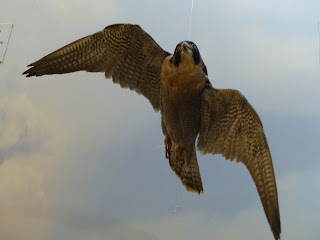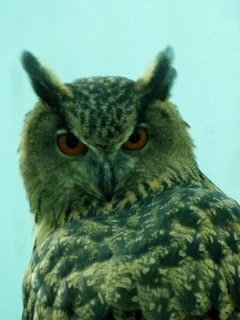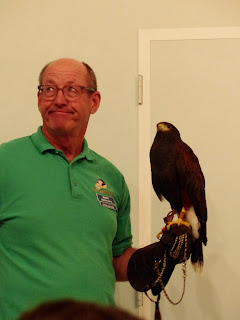11/3/17 - Got a little sidetracked when we got to Arizona and saw friends we hadn't seen since last year. We went here in September.
The World Center for Birds of Prey in Boise, Idaho, is the headquarters for The Peregrine Fund, an international non-profit organization that conserves endangered raptors around the world. We missed the entrance sign, and were going to stop on the way out, but forgot.
Entrance is in the Gift Shop, then out the back door. There were a few birds in cages next to the building. This Bateleur Eagle is from Africa, where he's "Near Threatened". Don't think I'd even heard of this one before.
There was a Turkey Vulture right next door to him. We've seen these guys before. They live in both North and South America, so are pretty common. There was a volunteer who was talking about how beneficial they are because they eat carrion, which helps prevent disease. Like many species of wildlife, the use of DDT for insect control in the 50s and 60s killed a lot of them off, but their population status is now considered "Least Concern". (I'm pretty sure that doesn't just mean someone didn't like these rather ugly birds. The eagle is much prettier, but maybe the vulture's mother found him adorable.)
Just around the corner is the Condor Cliffs Exhibit. The California Condors are the original project of the Center. These condors are the largest bird in North America--and the most endangered one. Even George's wingspan isn't as wide as a condor's.
In 1982 there were only 22 left in the world, and every single one of them was placed in captive breeding programs. This place has more than any other facility. They breed them here, and release young ones at Vermilion Cliffs National Monument in Arizona, just north of the Grand Canyon.
Again, not a candidate for the Beautiful Raptor Pageant, but just because you're ugly doesn't mean you should have to go extinct. This year they released 18 California Condors to soar high above the Grand Canyon. Their status is now officially "Critically Endangered", which is a whole lot better than "Extinct"!
If you look closely at the birds above, you'll see numbers on them. (One is 44 and the other is something else.) We asked the guy that did the live bird presentation what the numbers were, but he didn't know. I'm thinking that instead of names, they gave them numbers when they were hatched. There are now 446 condors flying around in the world.
After checking out the condors, I left George talking to some people and wandered back to the other cages. This Ornate Hawk-Eagle is from forests in Central and South America, and is "Near Threatened".
The Bald Eagle is the only eagle unique to North America. He's "Least Concern" too.
We wandered around inside the Velma Morrison Interpretive Center, which has a lot of displays and exhibits about different kinds of raptors. The condor exhibit explained a lot about recovery and had one that obviously didn't make it hanging from the ceiling.
Neither did the Peregrine Falcon below, although the species was removed from the "Endangered" list in 1999.
They have Discovery Room for kids. These two were having a ball...never did see them learn to fly, but they did run around a lot flapping their wings.
Back behind the exhibits is a Viewing Hall where you can see more live birds. I kept forgetting about the double-paned windows between me and them, so I'd get too close and clunk my camera--or my nose--on the glass. The Orange-breasted Falcon is a "Near Threatened" bird from South America.
The Eurasian Eagle-Owl is a big owl from Europe. His scientific name is fun--he's a Bubo bubo--has something to do with sounds the male makes. I'd call him "Bubba".
The Northern Aplomado Falcon from the American Southwest and Mexico is the only falcon in the United States on the Endangered Species List. He's a wee-bit scruffy.
At 2:00 we went to the Live Bird Presentation. One of the docents was doing a show-and-tell on a couple of the birds they have in the program.
When he was done, he took the whole group across to the other side of the parking lot to the Archives of Falconry & Library building. There they have a lot of things relating to falconry. They have a lot of material for researchers, including the most comprehensive English-language falconry library in the world. There is falcon art and displays with equipment the falconers use, like the leather hoods they put on the birds before they send them to hunt.
One wing was sponsored by the son of His Royal Highness Sheikh Zayed bin Sultan Al Nahyan from the United Arab Emirates, designed to show how Arabian falconry is practiced by nomadic Bedouins today. There's an exhibit of a Bedouin tent, complete with furniture and rugs. Home with all the creature comforts, transported on a camel, it looks like the Arabian version of RVing.
In this case, it's not the falcons that are endangered--it's their prey. The chief quarry of the Arabian falconers is the Houbara Bustard, which is endangered in some locations, but doing well in others. Sheikh Zayed set up an extensive captive breeding program for them.
I think the Archives are a great idea, and probably more interesting to falconers. Good plan to save the stuff before it all disappears.
Back outside, I'd hoped there was going to be a demonstration of one of the raptors in flight, but we were a week early for the Fall Flights. Maybe another time when we're in Boise.
Back outside, I'd hoped there was going to be a demonstration of one of the raptors in flight, but we were a week early for the Fall Flights. Maybe another time when we're in Boise.
More pictures here: Birds of Prey Center





















Post a comment.
Post a Comment
Please leave comments here: